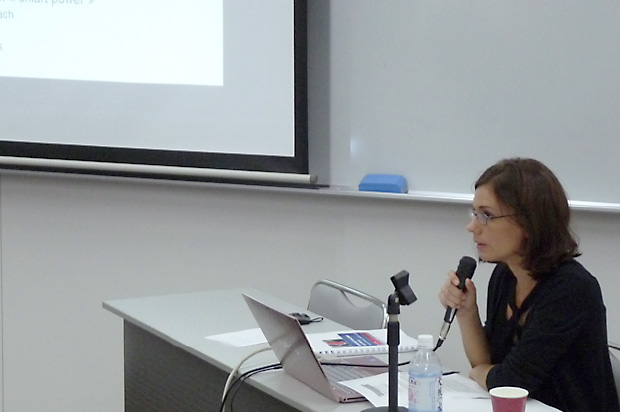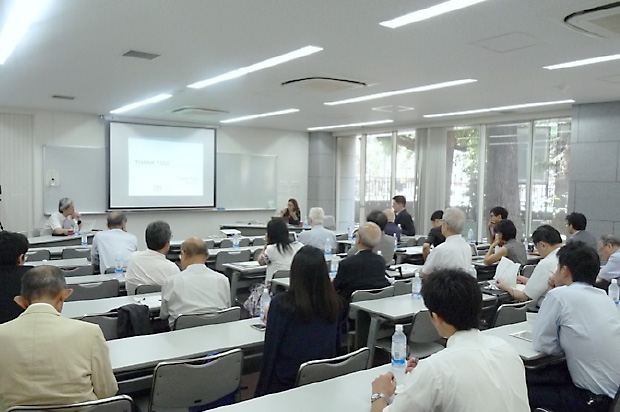SSU Forum with Céline Pajon
| Date: | Tuesday, July 12 2016, 10:30-12:00 |
|---|---|
| Venue: | Seminar Room 2, 1st Floor, Kojima Hall |
| Subject: | Long Term Dynamics of the Japan-US Alliance |
| Lecture: | Céline Pajon, French Institute for International Relations(IFRI), Center for Asian Studies, Research Fellow |
| Language: | English |
| Hosted by: | Security Studies Unit, Policy Alternatives Research Institute, the University of Tokyo |
The SSU was delighted to host Ms Céline Pajon, researcher at the French Institute of International Relations (IFRI), who delivered a talk entitled “Long Term Dynamics of the Japan-US Alliance”.

The session was chaired by Professor Kiichi Fujiwara, Director of the Security Studies Unit. He introduced the speaker as a talented researcher on Japanese international political affairs, who is able to provide a fresh perspective on the Japan-US alliance, as she comes from a third country, namely France, thus allowing for a degree of neutrality in the otherwise often polarised discussion of the alliance in the Japanese context.
Ms Pajon thanked Professor Fujiwara and the SSU for the organisation of the event, and proceeded with the introduction of her talk's topic, which is directly linked to a book she has co-authored and it is now freely available online. She offered a general assessment of the alliance and its broader geopolitical meaning. The Japan-US alliance appears indeed as the cornerstone of regional and global order, as well as the basic foundation of Japan's defence and foreign policy posture. The alliance has always presented elements of asymmetry, as the US vows to defend Japan but not vice versa, in exchange for the right to have military bases on Japanese soil, and it always changed in accordance with the changing political landscape, but since 2015 something fairly unprecedented has happened: Japan has become the proactive initiator of change in the alliance dynamic.
There are three main points which Ms. Pajon articulated about this dynamic: 1) the reinforcement and strengthening of the alliance; 2) the strategic narrative which underpins it; and 3) the potential long term tensions.
Looking at the first point, it is Lapalissian to say that the strengthening of the Japan-US alliance occurs against the background of the “rise of China”, the “power shift” both at global but especially at regional level. There has been a sustained trend for the expansion and deepening of operational integration, including joint training. Besides, there has been a push for a more “global” scope in planning and action, as well as a closer link to third parties, particularly Australia. Japan's approach to the alliance has been transformed by the urgency of keeping the US involved in the region, and one of the ways in which Tokyo is trying to achieve that is to provide as many incentives as possible for the US to confirm their presence.
Secondly, in terms of the strategic debate underpinning the alliance from a Japanese perspective, Ms Pajon has made use of the Michishita/Samuels model of analysis in order to explain the various theoretical options open to Japan's strategy, remarking that today, also according to the opinions of numerous Japanese officials she has collected, the general perception is that there is no real alternative to the alliance with US, if Japan wants to retain its autonomy in the face of a rising China.
Thirdly, Ms Pajon has highlighted some limitations and potential frictions between Washington and Tokyo, which cluster mostly around three points: a) Possible divergences arising from expectation gaps between what Japan aims to achieve, and what the US is interested in. In general, one may say that the US is preoccupied with the global strategic situation, while Japan appears overwhelmingly concentrated on the East Asian region. b) There is a consistent part of the Japanese ruling class and the electorate who, even for opposite reasons, wish for more autonomy in the long term, whereby Japan will completely recover its status of totally independent political actor. This is also true for the case in which the rationale for the alliance's renewed strength, namely the “rise of China”, should somehow weaken in the future. c) A problem persists with US military presence in Japan, particularly in Okinawa (Futenma base).

In conclusion, Ms Pajon remarked that the best way to cope with problems in the alliance is to better coordinate reciprocal views, deepen ties with like-minded partners, as well as expand non-combat and non-military cooperation.
